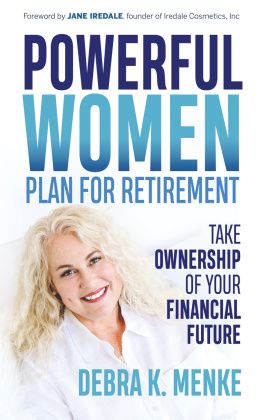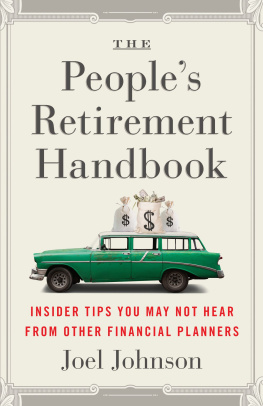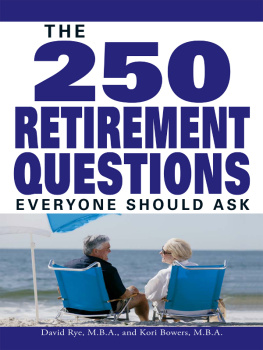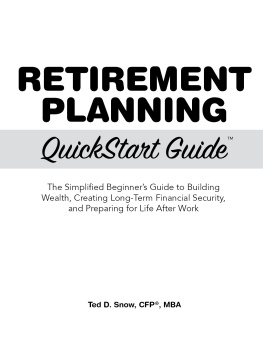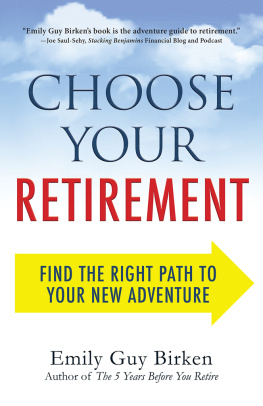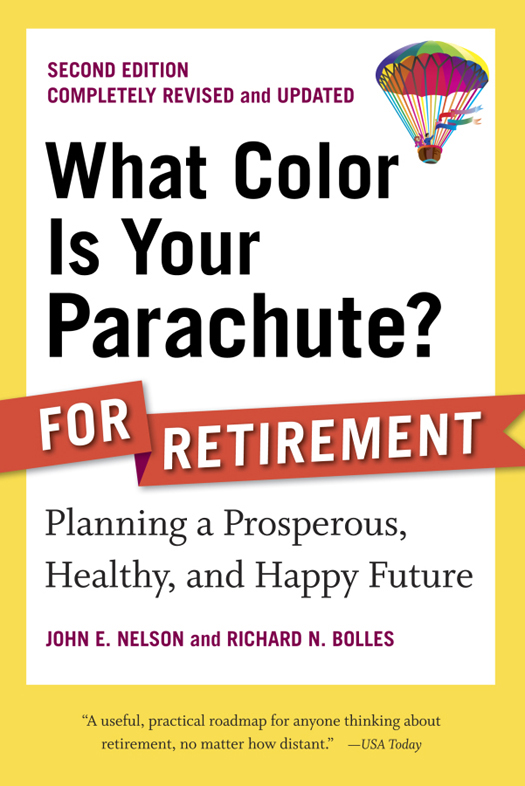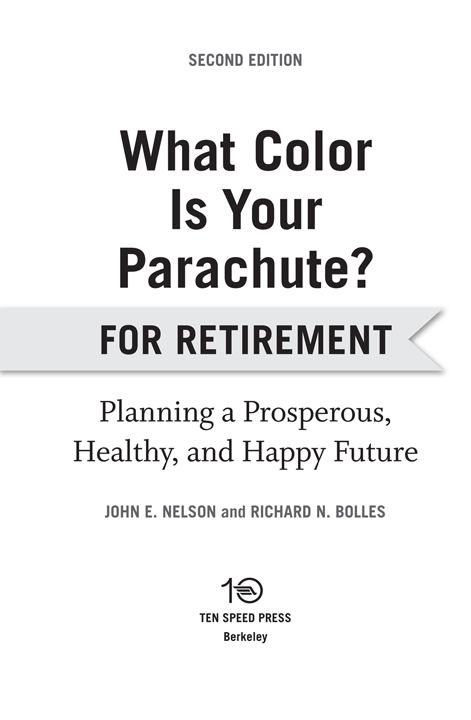Publishers Note: This book is intended to provide general information about retirement life planning. Neither the author nor the publisher is engaged in rendering legal, accounting, financial, medical, or psychological services. As each situation is unique, questions specific to your particular situation should be addressed to an appropriate professional for proper evaluation and advice. The author and publisher disclaim any liability, loss, or risk that is incurred as a consequence of the use and application of any of the contents of this work.
Copyright 2007, 2010 by John E. Nelson and Richard N. Bolles
All rights reserved.
Published in the United States by Ten Speed Press, an imprint of the
Crown Publishing Group, a division of Random House, Inc., New York.
www.crownpublishing.com
www.tenspeed.com
Ten Speed Press and the Ten Speed Press colophon are registered trademarks
of Random House, Inc.
A previous edition of this work was published in the United States by Ten Speed Press, Berkeley, CA, in 2007.
Library of Congress Cataloging-in-Publication Data
Nelson, John E.
What color is your parachute? for retirement : planning a prosperous, healthy, and happy future / John E. Nelson and Richard N. Bolles.2nd ed.
p. cm.
Bolless name appears first in the previous ed.
Includes index.
Summary: A revised edition of the definitive retirement guide for people of all career stagesProvided by publisher.
1. Retirement incomePlanning. 2. RetirementPlanning. I. Bolles,
Richard Nelson. II. Bolles, Richard Nelson. What color is your parachute? for retirement. III. Title.
HG179.B575 2010
332.024014dc22
2010005578
eISBN: 978-1-60774-331-6
v3.1
To my mother.
You were a better role model than I knew.
J OHN E. N ELSON
Contents
Chapter ONE
Retirement Is DeadLong Live Retirement!
The retirement we knew is disappearing. Do you want a finish line or a marker on your journey? Ten ways to customize your transition.
Chapter TWO
The Retirement Youve Always Wanted but Forgot About
What we all want in life. Six fields of knowledge that support well-being.
What are the elements of your ideal retirement?
Chapter THREE
The Life You Can Live (Right Now)
How we make big life decisions. Are you buying a lifestyle or creating a life? Ten steps to activate your core values.
Chapter FOUR
Retirement Economics Is More Than Personal Finance
A family approach to retirement economics. The original pyramid scheme.
Your three-legged stool is wobbly. The spending-saving seesaw.
Chapter FIVE
A New Approach to Retirement Security
Five pillars are better than three legs. How to use automatic systems for saving, investing, and income. Where to find a fiduciary advisor.
Chapter SIX
The Nature of Space and Time
Four layers of retirement geography. Is your dream home a nightmare? Calling it a community doesnt make it one. Your essential region.
Chapter SEVEN
MedicineWhos in Charge?
How much medicine will you buy? Your medical philosophy, and what it costs. Choose medical relationships before you need them.
Chapter EIGHT
Health from the Inside Out
Our biology plus medicine equals health. Whats your biological age? The
longevity class reunion. Three practices for biological vitality.
Chapter NINE
A New Chapter in Psychology
Are you trying to fix your weaknesses? Three paths to happiness. Staying engaged in workand retirement, too! Your greatest strengths.
Chapter TEN
Happiness Is Only Real When Shared
Work connections wither and die. Build relationships in advance. Your three levels of social connection. Retirement with that special someone.
Chapter ELEVEN
The New Retirementan Undivided Life
Connect your life circles for well-being. Do you have a calling? Dont wait for retirementstart living your ideal life now!
Preface
This book is part of what we call The Parachute Library. Like all books in that Library, it is not intended as a substitute or replacement for its best-selling centerpiece, What Color Is Your Parachute? A Practical Guide for Job-Hunters and Career-Changers (ten million copies in print), but as a supplement to it.
Why do we need a supplement? Well, each time of Life has special issues and special challenges, where we all could use a little extra guidance. The time of Life from age fifty, on, is one of those times. I have a friend named John Nelson, who is an expert on that time of Life, and therefore I have asked him to write this book.
My contribution to this book is twofold: (1) To frame some of the questions and challenges during this period, as I have done in my earlier work The Three Boxes of Life, and How to Get Out of Them: An Introduction to Life/Work Planning (1978). (2) To write this introduction and overview, to get us going.
The time of Life that we are talking about here is traditionally called Retirement. Some people love that word. Im not one of them. For me, it implies being put out to pastureto borrow an image from a cow. It implies a kind of parole from a thing called work, which is assumed to be onerous, and tedious. It implies disengagement from both work and Life, as one patientlyor impatientlywaits to die. It thinks of Life in terms of work.
I prefer instead to think of Life in terms of music. My favorite metaphor is that of a symphony. A symphony, traditionally, has four parts to itfour movements, as theyre called. So does Life. There is infancy, then the time of learning, then the time of working, and finally, this time that we are talking about, often called retirement. But if we discourage the use of the word retirement, then this might better be called the Fourth Movement.
The Fourth Movement, in the symphonic world, is a kind of blank slate. It was and is up to the composer to decide what to write upon it. Traditionally, the composer writes of triumph, victory, and joyas in Beethovens Symphony #3, the Eroica. But it may, alternatively, be a kind of anticlimactic, meandering piece of musicas in Tchaikovskys Symphony #6, the Pathetique. There the Third Movement ends with a bombastic, stirring march. The Fourth Movement, immediately following, is subdued, meditative, meandering, and sounds almost like an afterthought.
Well, there are our choices about our own lives: Shall the Fourth Movement, the final movement, of our lives be pathetique or eroicapathetic or heroic? Your call!
I like this defining of our lives in terms of music, rather than in terms of work.
To carry the metaphor onward, in this Fourth Movement of our lives, we have instruments, which we must treat with care. They are: our body, our mind, our spirit, and what we poetically speak of as our heart, which Chinese medicine calls the Emperor. Body, mind, spirit, heart. Some of these instruments are in shiny, splendid condition. Others are slightly dented. Or greatly dented. But these are the instruments that play the musical notes and themes of this time of our lives.



